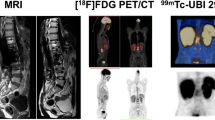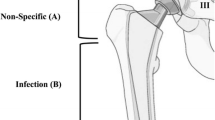Abstract
Objective
18F-fluorodeoxyglucose-PET/CT is the imaging modality of choice for the diagnosis of postoperative spine infection. Published interpretation criteria are variable and often incompletely described. The objective was to develop a practical and standardized approach.
Materials and methods
Two-hundred-twenty-seven FDG-PET/CTs performed on 140 postoperative patients over a 7-year period were reviewed retrospectively. The presence or absence of infection was determined from clinical history, microbiology, other investigations, and clinical outcome during a minimum 6-month follow-up.
Results
No activity attributable to normal healing was seen in the post-discectomy space or at the bone-hardware interface in the absence of a complication at any stage. Within the incision, activity from normal healing persisted for months. Wound infections were diagnosed clinically, and most had already been treated before FDG-PET/CT was done to assess deep structures.
With proven infection, 95% of cases had activity in bone or soft tissue outside the surgical field. The remaining 5% had activity confined to the post-discectomy space. Sterile hardware loosening may cause elevated activity which remains confined to the bone/hardware interface.
Pathogens are introduced directly at the time of surgery and may be avirulent resulting in indolent infection with low-grade activity. At the same time, activity from non-infectious causes can be intense. A semi-quantitative method using SUVmax performed poorly compared with assessment of the distribution of activity.
Conclusion
These observations have been incorporated into a checklist which is now being used at the time of interpretation. The potential sensitivity and specificity in the diagnosis of infection are close to 100%.






Similar content being viewed by others
References
Treglia G, Pascale M, Lazzeri E, van der Bruggen W, Delgado Bolton RC, Glaudemans A. Diagnostic performance of (18)F-FDG PET/CT in patients with spinal infection: a systematic review and a bivariate meta-analysis. Eur J Nucl Med Mol Imaging. 2020;47(5):1287–301.
Riccio SA, Chu AKM, Rabin HR, Kloiber R. Fluorodeoxyglucose positron emission tomography/computed tomography interpretation criteria for assessment of antibiotic treatment response in pyogenic spine infection. Can Assoc Radiol J. 2015;66(2):145–52.
Kloiber R, Koslowsky IL, Tchajkov I, Rabin HR. Pattern-based interpretation criteria for (18)F-fludeoxyglucose positron emission tomography/computed tomography in the assessment of pyogenic spine infection. Can Assoc Radiol J. 2018;69(4):397–408.
Yu GJ, Koslowsky IL, Riccio SA, Chu AKM, Rabin HR, Kloiber R. Diagnostic challenges in pyogenic spinal infection: an expanded role for FDG-PET/CT. Eur J Clin Microbiol Infect Dis. 2018;37(3):501–9.
De Winter F, Gemmel F, Van De Wiele C, Poffijn B, Uyttendaele D, Dierckx R. 18-Fluorine fluorodeoxyglucose positron emission tomography for the diagnosis of infection in the postoperative spine. Spine. 2003;28:1314–9.
Ledermann HP, Schweitzer ME, Morrison WB, Carrino JA. MR imaging findings in spinal infections: rules or myths? Radiology. 2003;228:506–14.
Lazzeri E, Bozzao A, Cataldo MA, Petrosillo N, Manfrè L, Trampuz A, et al. Joint EANM/ESNR and ESCMID-endorsed consensus document for the diagnosis of spine infection (spondylodiscitis) in adults. Eur J Nucl Med Mol Imaging. 2019;46(12):2464–87.
Bagrosky BM, Hayes KL, Koo PJ, Fenton LZ. 18F-FDG PET/CT evaluation of children and young adults with suspected spinal fusion hardware infection. Pediatr Radiol. 2013;43(8):991–1000.
Schiesser M, Stumpe KD, Trentz O, Kossmann T, Von Schulthess GK. Detection of metallic implant-associated infections with FDG PET in patients with trauma: correlation with microbiologic results. Radiology. 2003;226(2):391–8.
Inanami H, Oshima Y, Iwahori T, Takano Y, Koga H, Iwai H. Role of 18F-fluoro-D-deoxyglucose PET/CT in diagnosing surgical site infection after spine surgery with instrumentation. Spine. 2015;40(2):109–13.
Frenkel Rutenberg T, Baruch Y, Ohana N, Bernstine H, Amitai A, Cohen N, et al. The role of 18F-fluorodeoxyglucose positron-emission tomography/computed tomography in the diagnosis of postoperative hardware-related spinal infections. Isr Med Assoc J. 2019;21(8):532–7.
Follenfant E, Balamoutoff N, Lawson-Ayayi S, Dutronc H, Dupon M, Vital JM, et al. Added value of [(18)F]fluorodeoxyglucose positron emission tomography/computed tomography for the diagnosis of post-operative instrumented spine infection. Joint Bone Spine. 2019;86(4):503–8.
Dauchy FA, Dutertre A, Lawson-Ayayi S, de Clermont-Gallerande H, Fournier C, Zanotti-Fregonara P, et al. Interest of [(18)F]fluorodeoxyglucose positron emission tomography/computed tomography for the diagnosis of relapse in patients with spinal infection: a prospective study. Clin Microbiol Infect. 2016;22(5):438–43.
Jamar F, Buscombe J, Chiti A, Christian PE, Delbeke D, Donohoe KJ, et al. EANM/SNMMI guideline for 18F-FDG use in inflammation and infection. J Nucl Med. 2013;54(4):647–58.
Kumar R, Indrayan A. Receiver operating characteristic (ROC) curve for medical researchers. Indian Pediatr. 2011;48(4):277–87.
Virk SS, Niedermeier S, Yu E, Khan SN. Adjacent segment disease. Orthopedics. 2014;37(8):547–55.
Parchi PD, Evangelisti G, Andreani L, Girardi F, Darren L, Sama A, Lisanti M. Postoperative spine infections. Orthop Rev (Pavia). 2015;7(3):5900.
Rutherford EE, Tarplett LJ, Davies EM, Harley JM, King LJ. Lumbar spine fusion and stabilization: hardware, techniques, and imaging appearances. Radiographics. 2007;27(6):1737–49.
Spirig JM, Sutter R, Götschi T, Farshad-Amacker NA, Farshad M. Value of standard radiographs, computed tomography, and magnetic resonance imaging of the lumbar spine in detection of intraoperatively confirmed pedicle screw loosening-a prospective clinical trial. Spine J. 2019;19(3):461–8.
Kasliwal MK, Tan LA, Traynelis VC. Infection with spinal instrumentation: review of pathogenesis, diagnosis, prevention, and management. Surg Neurol Int. 2013;4(Suppl 5):S392-403.
Author information
Authors and Affiliations
Corresponding author
Ethics declarations
Ethical approval
All procedures performed in studies involving human participants were in accordance with ethical standards of the institutional research committee and with the 1964 Helsinki declaration and its later amendments or comparable ethical standards.
Informed consent
Informed consent was obtained from all individual participants included in the study in the manner specified by the institutions’ ethics review board.
Data Availability
The data that support the findings of this study are available from the corresponding author, Dr. Lafford, upon reasonable request.
Conflict of interest
The authors declare no competing interests.
Additional information
Publisher's Note
Springer Nature remains neutral with regard to jurisdictional claims in published maps and institutional affiliations.
Rights and permissions
Springer Nature or its licensor (e.g. a society or other partner) holds exclusive rights to this article under a publishing agreement with the author(s) or other rightsholder(s); author self-archiving of the accepted manuscript version of this article is solely governed by the terms of such publishing agreement and applicable law.
About this article
Cite this article
Kloiber, R., Lafford, H., Koslowsky, I.L. et al. A practical approach to interpretation of 18F-fluorodeoxyglucose positron emission tomography/computed tomography for postoperative spine infection. Skeletal Radiol 53, 741–752 (2024). https://doi.org/10.1007/s00256-023-04474-6
Received:
Revised:
Accepted:
Published:
Issue Date:
DOI: https://doi.org/10.1007/s00256-023-04474-6




